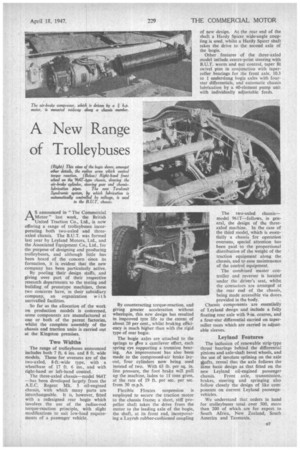A New Range of Trolley buses
Page 41

If you've noticed an error in this article please click here to report it so we can fix it.
AS announced in "The Commercial Motor" last week, the British United Traction Co., Ltd., is now offering a range of trolleybuses incorporating both two-axled and threeaxled chassis. The B.U.T. was formed last year by Leyland Motors, Ltd., and the Associated Equipment Co., Ltd., for the purpose of designing and producing trolleybuses, and although little has been heard of the concern since its formation, it is evident that the new company has been particularly active.
By pooling their design staffs, and giving over part of their respective research departments to the testing and building, of prototype machines, these two concerns have, in their subsidiary company, an organization with unrivalled facilities.
So far as the allocation of the work on production models is concerned, some components are manufactured at one or both of the parent factories, whilst the complete assembly of the chassis and traction units is carried out at the Kingston. premises.
Two Widths The range of trolleybuses announced includes both 7 ft. 6 ins. and 8 ft. wide models. Those for overseas are of the two-axled, 8-ft.-wide type, with a wheelbase of 17 ft. 6 ins., and with right-hand or left-hand control.
The three-axled chassis—model 964T —has been developed largely from the A.E.C. Regent Mk. 3 oil-engined chassis, with which many parts are interchangeable. It is, however, fitted with a redesigned rear bogie which involves the use of the radius-rod torque-reaction principle, with slight modifications to suit low-load requirements of a passenger vehicle. By counteracting torque-reaction, and giving greater acceleration without wheelspin, this new design has resulted in improved tyre fife to the extent of about 20 per cent., whilst braking efficiency is much higher than with the rigid type of rear bogie.
The bogie axles are attached to the Springs to gilve a cantilever effect, each spring eye supporting a trunnion bearing. An improvement has also been made to the compressed-air brake layout, four cylinders now being used instead of two. With 65 lb. per sq. in, line pressure, the foot brake will pull up • the machine, laden to 1 tons gross, at the rate of 19 ft. per sec, per sec. from 30 m.p.h.
Flexible Floatex suspension is employed to secure the traction motor to the chassis frame; a short, stiff propeller shaft takes the drive from the motor to the leading axle of the bogie, the shaft, at its front end, incorporating a Layrub rubber-cushioned coupling
of new design. At the rear end of the shaft a Hardy Spicer wide-angle coupling is used, whilst a Hardy Spicer shaft Lakes the drive to the second axle of the bogie.
Other features of the three-axled model include centre-point steering with B.U.T. worm and nut control, taper fit swivel pins in conjunction with taperroller bearings for the front axle, 10.3 to 1 underslung bogie axles with fourstar differentials, and automatic chassis lubrication by a 40-element pump unit with individually adjustable feeds.
The two-axled chassis— model 961T—follows, in general, the design of the threeaxled machine. In the case of the third model, which is essentially a chassis for operation overseas, special attention has been paid to the proportional distribution of the weight of the traction equipment along the chassis, and to ease maintenance of the control equipment.
The combined master controller and reverser is located under the driver's seat, whilst the contactors are arranged at the rear end of the chassis, being made accessible via doors provided in the body.
Chassis components are essentially of Leyland design and include a fully floating rear axle with 9-in, centres, and a four-star differential carried on taperroller races which are carried in adjustable sleeves.
Leyland Features
The inclusion of renewable strip-type thrust bearings behind the differential pinions and axle-shaft bevel wheels, and the use of involute splining on the axle shafts, reveal that the axle follows the same basic design as that fitted on the new Leyland oil-engined passenger chassis. Front axle, transmission, brakes, steering and springing also follow closely the design of like components on current Leyland passengel vehicles.
We understand that orders in hand for trolleybuses total over 500, more than 200 of which are for export to South Africa, New Zealand, South America and Tasmania.




















































































